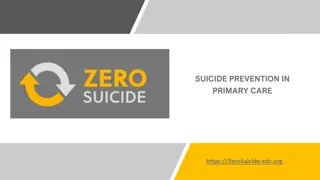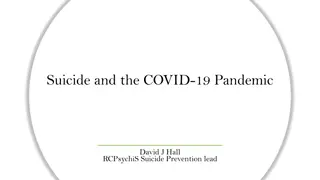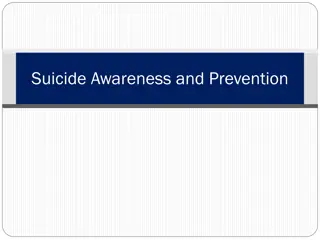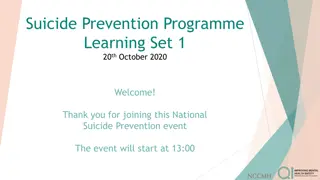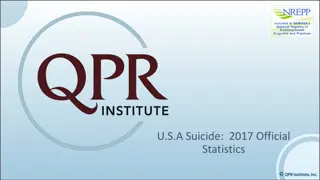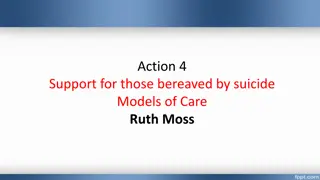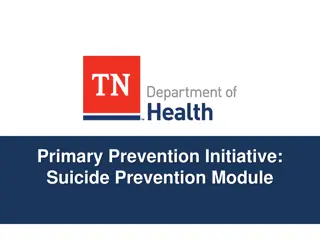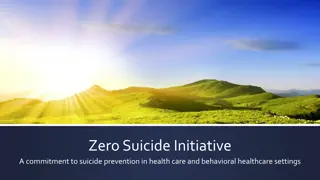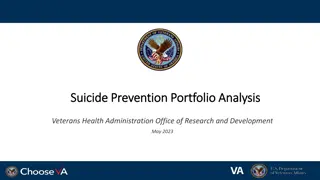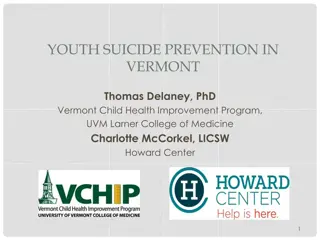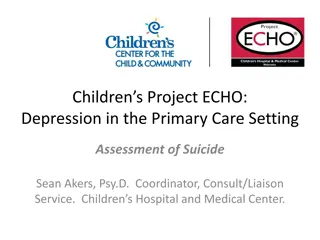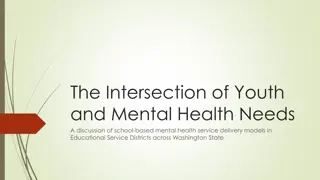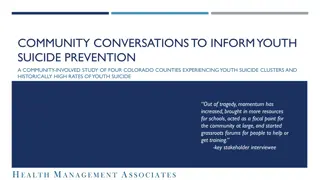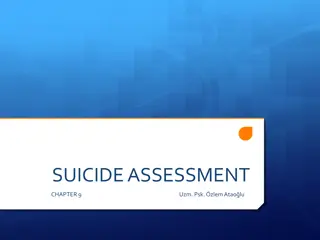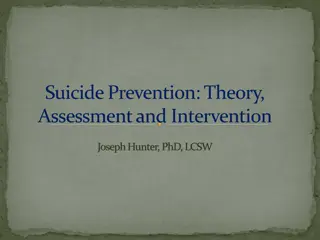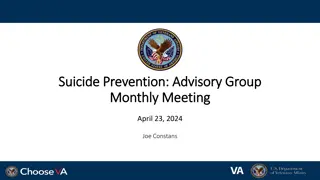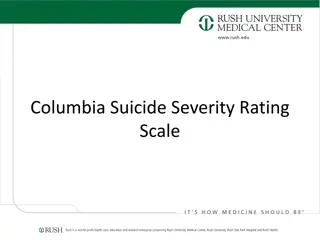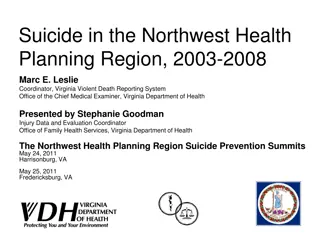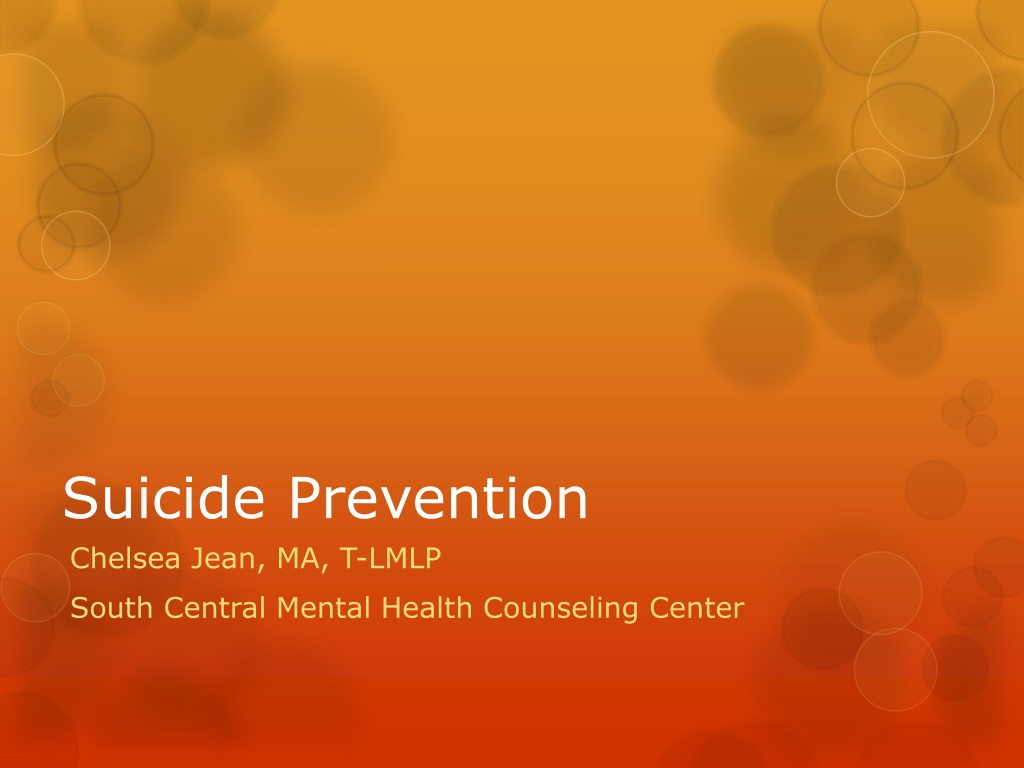
Insights on Suicide Prevention and Statistics
Explore vital information on suicide prevention, definitions, warning signs, and statistics such as the percentage of students considering suicide and the number of suicides in Kansas and the U.S. Understand the importance of addressing mental health challenges to prevent suicide effectively.
Download Presentation

Please find below an Image/Link to download the presentation.
The content on the website is provided AS IS for your information and personal use only. It may not be sold, licensed, or shared on other websites without obtaining consent from the author. If you encounter any issues during the download, it is possible that the publisher has removed the file from their server.
You are allowed to download the files provided on this website for personal or commercial use, subject to the condition that they are used lawfully. All files are the property of their respective owners.
The content on the website is provided AS IS for your information and personal use only. It may not be sold, licensed, or shared on other websites without obtaining consent from the author.
E N D
Presentation Transcript
Suicide Prevention Chelsea Jean, MA, T-LMLP South Central Mental Health Counseling Center
Definitions Suicide Death Caused by self-directed injurious behavior with an intent to die as a result of the behavior Suicide Attempt A non-fatal, self-directed, potentially injurious behavior with an intent to die as a result of the behavior; may or may not result in injury Suicidal Ideation Thinking about, considering, or planning suicide
Warning Signs/Risk Factors By the Numbers Action Steps Diversity Resources $200 $200 $200 $200 $200 $400 $400 $400 $400 $400 $600 $600 $600 $600 $600 $800 $800 $800 $800 $800
Within the past year, what percentage of students in grades 9-12 seriously considered attempting suicide? ANSWER ANSWER
17% of students seriously considered attempting suicide. That is 1 out of every 6 students
Among middle and high school students, suicide is the leading cause of death? ANSWER ANSWER
Suicide is the 2nd leading cause of death among middle and high school students
In Kansas in 2014, how many suicides were there? ANSWER ANSWER
Kansas had 455 suicides in 2014 (21st in the nation)
How many suicides occurred in the U.S. in 2013? ANSWER ANSWER
In the U.S. in 2013, there were 41,149 suicides. That is equal to 1 every 13 minutes
In 2013: Which gender has a higher suicide rate? Which has a higher rate of suicidal ideation? ANSWER ANSWER
Suicide Rate: Males Suicidal Ideation: Females
In terms of race/ethnicity, which group(s) have the highest suicide rates? ANSWER ANSWER
Highest: White/Caucasian (14.7%) Second Highest: American Indian and Alaska Natives (10.9%)
In terms of academic achievement, which students may be at a higher risk for suicide? ANSWER ANSWER
THIS DOES NOT MEAN THAT GIVING A Students receiving D s/F s STUDENT A FAILING GRADE CAUSES THEM TO COMMIT SUICIDE
How do suicide rates for LGBTQ+ youth compare with their straight peers? ANSWER ANSWER
The suicide rate for LGB youth is 4 times higher than straight youth and the suicide rate for questioning youth is 2 times higher
What are some health/mental health conditions that could be risk factors for suicide? ANSWER ANSWER
Depression Anxiety Disorders Bipolar Disorder Schizophrenia Substance Abuse Disorders Conduct Disorder Borderline or Antisocial Personality Disorders Psychotic Disorders Serious, chronic pain Chronic health conditions
What might someone who is considering suicide talk about? ANSWER ANSWER
Some possibilities: Death/Dying Feeling like a burden to others Hopelessness/having no reason to live Feeling trapped or isolated from others Experiencing unbearable pain Seeking revenge Killing themselves
What are some environmental and historical risk factors for suicide? ANSWER ANSWER
Environmental Historical Stressful life events Prolonged stress and/or harassment Access to lethal means Exposure to another person s suicide or graphic, sensationalized accounts of suicide Previous suicide attempts Family history of suicide and/or suicide attempts
What are some warning signs (e.g., behavior and mood) for suicide? ANSWER ANSWER
Behavior Mood Withdrawing from activities Isolating from friends and family Sleeping too little or too much Behaving recklessly Increased drug/alcohol use Searching for methods online Showing aggression Visiting or calling people to say goodbye Giving away prized possessions Depression Loss of interest Anxiety Rage Humiliation Irritability/Agitation Displaying extreme mood swings
What should you do with a student who poses an immediate risk for suicide? ANSWER ANSWER
Immediate Risk: Talking about wanting to die/killing oneself Looking for a way to kill oneself Talking about feeling hopeless or having no reason to live Action Steps: Ask them directly if they are thinking about killing themselves Supervise the student constantly or ensure that he/she is supervised in a secure environment until they can be seen by a mental health contact until you can get further help Encourage and/or accompany the student to seek help and support from a crisis specialist, therapist, doctor, and/or clergy member Remove any objects that could be used in a suicide attempt Call SAMHSA s National Suicide Prevention Lifeline at 1-800-273- 8255 and follow their guidance If danger for self-harm seems imminent, call 911
Before becoming an immediate risk of suicide, how should you respond to a student who may be at risk of suicide? ANSWER ANSWER
Some protective factors against suicide include: Connection to school Safe schools Academic Achievement Self-esteem
What are some initial steps that can be taken to support students? ANSWER ANSWER
Before ever suspecting any type of suicide risk, work to connect with your students Demonstrate, both in words and in actions, that you are a safe individual they can approach when they need help Reach out to students at risk to see how they are doing Be willing to listen without judging and show you care by being present with their feelings Check in with the student and keep in touch to see how they are doing Provide students with resources dealing with the topic of suicide Consult with other colleagues/professionals about your concerns
What is your schools policy for intervening with a suicidal student? ANSWER ANSWER
Crisis situation Call 316.321.6036 during normal business hours You will be transferred to Jena or another Crisis Case Manager
ONLINE RESOURCES REVEAL REVEAL
Substance Abuse and Mental Health Services Administration www.samhsa.gov/suicide-prevention Preventing Suicide: A Toolkit for High Schools Suicide Prevention Resource Center www.training.sprc.org Self-paced online courses to educate and improve skills in suicide prevention Toolkits, trainings, and resources available High School, Middle School, and Adolescent information pages Suicide Awareness Voices of Education www.save.org National Suicide Prevention Lifeline (Spanish version available) www.suicidepreventionlifeline.org or 1-800-273-8255 24/7 crisis support (Safety and Crisis Coping Plans available) Suicide Prevention Toolkit The Jason Foundation www.jasonfoundation.com Staff Development Series The Trevor Project www.thetrevorproject.com
SOCIAL NETWORKING ADVOCACY REVEAL REVEAL
Social Media Facebook Protect and Care Team: Report Post Twitter: Report self harm Tumblr: Email information to Tumblr including Tumblr blog URL YouTube: Flag video MySpace: Report abuse link at the bottom of the page WordPress: Blog menu Report this content TrevorSpace: Social networking site for LGBTQ+ youth ages 13-24, their friends, and allies
RESOURCES FOR STUDENTS REVEAL REVEAL
Apps: MY3 and A Friend Asks KnowBullying and I Am A Witness The Trevor Project and Support Center TrevorSpace: Social networking site for LGBTQ+ youth ages 13-24, their friends, and allies Trevor Lifeline: 1-866-488-7386 (text and chat also available) Lifeguard Workshop National Suicide Prevention Lifeline (Spanish version available) www.suicidepreventionlifeline.org or 1-800-273-8255 American Foundation For Suicide Prevention s More Than Sad program teaches high school students about depression and suicide and provides modules for educators as well. The Boys Town National Hotline www.yourlifeyourvoice.org Offers 4 options: Call, text, chat, or email Free resources dealing with preventing suicide (cards, flyers, etc.)
LOCAL RESOURCES REVEAL REVEAL
COMCARE SCMHCC
References Centers for Disease Control and Prevention (CDC). Web-based Injury Statistics Query and Reporting System (WISQARS) [Online]. (2013, 2011) National Center for Injury Prevention and Control, CDC (producer). CDC. (2016). Sexual Identity, Sex of Sexual Contacts, and Health-Risk Behaviors Among Students in Grades 9-12: Youth Risk Behavior Surveillance. Atlanta, GA: U.S. Department of Health and Human Services. Grossman, A.H. & D'Augelli, A.R. (2007). Transgender Youth and Life-Threatening Behaviors. Suicide and Life-Threatening Behaviors.37(5), 527-37. IMPACT. (2010). Mental health disorders, psychological distress, and suicidality in a diverse sample of lesbian, gay, bisexual, and transgender youths. American Journal of Public Health. 100(12), 2426-32. Family Acceptance Project . (2009). Family rejection as a predictor of negative health outcomes in white and Latino lesbian, gay, and bisexual young adults. Pediatrics. 123(1), 346-52. Kann L, Kinchen S, Shanklin SL, et al. Youth Risk Behavior Surveillance United States, 2013. MMWR 2014; 63(ss04): 1-168. Centers for Disease Control and Prevention, National Youth Risk Behavior Survey, 2009 American Foundation for Suicide Prevention American Association of Suicidology http://www.youthsuicidewarningsigns.org/gatekeepers http://www.sprc.org/sites/default/files/resource-program/Teachers.pdf http://jasonfoundation.com http://www.yourlifeyourvoice.org/Pages/home.aspx http://www.thetrevorproject.org

